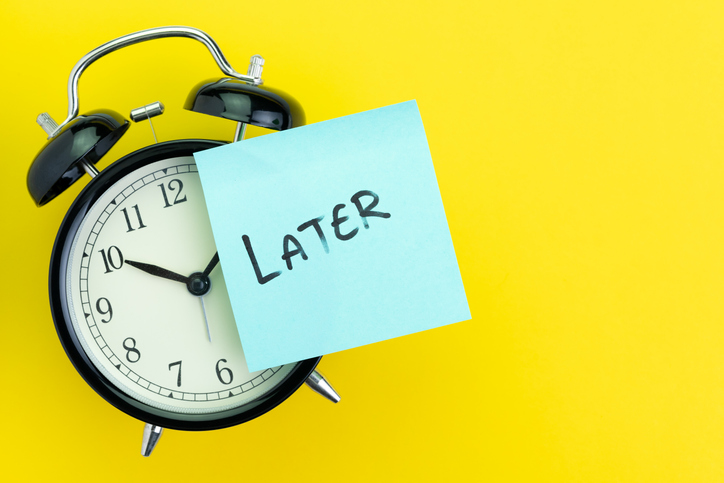 Many people with ADHD think that procrastination is a natural part of having ADHD and, all too often, see themselves as being incapable of getting things done that they would like to. However, most procrastinators rarely spend their time doing nothing. Instead, they are great at doing other things–sharpening pencils, picking the right music to listen to, tidying up the kitchen, etc.: anything but the main task. It seems that people with ADHD who procrastinate can be productive, as long as they’re focusing on a task that interests them and isn’t too challenging. When people engage in more interesting and approachable tasks, while putting off a more important task that might seem overwhelming, it’s known as productive procrastination.
Many people with ADHD think that procrastination is a natural part of having ADHD and, all too often, see themselves as being incapable of getting things done that they would like to. However, most procrastinators rarely spend their time doing nothing. Instead, they are great at doing other things–sharpening pencils, picking the right music to listen to, tidying up the kitchen, etc.: anything but the main task. It seems that people with ADHD who procrastinate can be productive, as long as they’re focusing on a task that interests them and isn’t too challenging. When people engage in more interesting and approachable tasks, while putting off a more important task that might seem overwhelming, it’s known as productive procrastination.
Procrastination, ADHD and anxiety
Procrastination can be debilitating. Your child with ADHD puts off her science project until the day before it’s due; you wait to clean your house until an hour before your in-laws arrive when your panic about having a messy living room kicks in. Adrenaline jumpstarts your activity level by fueling your dopamine pathways to fire. Often, procrastination is a form of anxiety; you’re not sure that you can do the task, project or assignment the way you want to, or at all. You’re worried and uncertain about the outcome, so you avoid it and set it aside until the due date is right in front of you. The term productive procrastination was first used by Piers Steel in his book, The Procrastination Equation. Productive procrastination is also known as ‘procrastivity‘ (Russell Ramsey, Ph.D.), positive procrastination or structural procrastination. Often, people put the big ticket items at the top of their to-do list–if they make one–followed by other easier items. Then, they aim for the low hanging fruit, even if it means they are wasting their time.
The short term relief of productive procrastination

Productive procrastination is a delay tactic that feels good because you are getting other things done while avoiding the onerous or unpleasant ones. You keep yourself busy with something else and stay away from the big thing that’s really looming over your head. You still do things that need to be accomplished, but what you work on is less urgent and important than the items you push aside. This makes you feel temporarily better because you feel like you are making progress and you are. But this short term relief increases your long-term stress.
Productive procrastination and the ADHD brain
Reducing productive procrastination relies on self-regulation and the ability to prioritize. You have to do a brain dump: identify what’s critical to do right now (emergencies and crises), and then sort out everything else. This is where folks with ADHD stumble; it’s tough to determine what is most important if urgency isn’t attached to it.  It’s harder to write a history paper or finish that work report than it is to do the laundry. Both need to be accomplished, but doing the laundry is less cognitively demanding than writing, so it gets pushed to the front. It’s a task that’s more on autopilot than the creative, organizing, sorting and persistence needed for research and writing. That’s why ADHD brains wander off to do those tasks first. Tasks that lend themselves to productive procrastination often have a time frame, with clear starting and endpoints. Doing the laundry or taking out the chicken to defrost for dinner is a finite task. Written work, especially if you throw in perfectionism, does not. The ADHD brain, driven towards the satisfaction and engagement from tangible, higher dopamine activities (those that seem more easily achievable), will focus on those activities first.
It’s harder to write a history paper or finish that work report than it is to do the laundry. Both need to be accomplished, but doing the laundry is less cognitively demanding than writing, so it gets pushed to the front. It’s a task that’s more on autopilot than the creative, organizing, sorting and persistence needed for research and writing. That’s why ADHD brains wander off to do those tasks first. Tasks that lend themselves to productive procrastination often have a time frame, with clear starting and endpoints. Doing the laundry or taking out the chicken to defrost for dinner is a finite task. Written work, especially if you throw in perfectionism, does not. The ADHD brain, driven towards the satisfaction and engagement from tangible, higher dopamine activities (those that seem more easily achievable), will focus on those activities first.
4 tips to combat productive procrastination:
1. Break down big tasks into smaller chunks
When you complete a piece of work, the work not only then seems smaller, but it also helps reduce your anxiety about completing it. Create a fixed time period to work on it so it doesn’t takeover your life. If you are parenting a child or teen with ADHD, prepare to assist them in chunking assignments and chores. Take stock of what you’ve accomplished when you take your pause. You’ve done something, keep going!
2. Pay attention to and address mood issues
Your son may not want to walk the dog because he’s not in the mood. Your daughter may pick an argument with you to avoid doing her math homework. You may struggle yourself to summon up the effort to sit down and balance your checking account. Overcoming your negativity using emotional control, and starting anyway, is what’s called for. With a smaller chunk of work as your goal, and a set start and stop time, you may find that you can summon the motivation to begin. Consider playing soothing or inspirational music, making a cup of your favorite tea or setting your timer. Ask your kids what would help them get into the frame of mind. The mood may never arrive, and that’s okay. Do it anyway. If you can’t, make a plan with a friend, family member or work buddy to help you talk about what’s bothering and sit down at your desk. If there is nobody you can reach, talk it out in your voice memo, or write it out for a short timed period. Think about how you will feel (positively) on the other side of doing some work.
3. Avoid negative self-talk, exaggeration and trickery
Negative self-talk will tell you that you can’t do things that you actually can do and probably have accomplished in the past. Anxiety often erases memories of courage and competence, and our negative memory bias doesn’t help. Anxiety also distorts things and can exaggerate the discomfort or impossibility of doing a task. Many people with ADHD also deceive themselves into thinking they cannot do something because it didn’t work before, without giving themselves a chance to try it again differently. This is true for kids, too. Challenge these parts by recalling previous successes. Think about a time when you dreaded doing something and left it until the last minute.
-
- How did that work out for you?
- What was the price you paid to complete it?
- Do you want to do that again?
Create some phrases to talk back to this part of you:
-
- Say, “Yes, I can do this, and I have succeeded in the past.”
- Or, “I’ve set my timers, I’ve planned my reward when I stop, so let’s get started.”
4. Build a strategy to reduce productive procrastination
Use your logic and ask for help when needed. These tools will continue to improve prioritization skills. Over and over, ask yourself (or your child) about the time and value factors related to the tasks on your to-do list:
-
- Is this urgent?
- What is the importance of this task?
Identify helpful supports–whether digital apps or human advise. Create a map of how to approach the hard stuff, how to set up meaningful incentives, and what tools you might need for self-regulation to get there. If you are really struggling, consider finding a buddy who can assist you or keep you company in this process. 
Read more blog posts:
- Planning and Prioritizing Practices for ADHD Brains: What’s the plan, and when do you start?!
- ADHD and Motivation: How stress reduces productivity and what you can do about it
- Personal Project Planners for ADHD Minds: Start managing tasks, time and ideas with this creative tool!
Watch on Dr. Saline’s YouTube Channel:
- ADHD & Productive Procrastination (ADDitude ADHD Q&A with Dr. Sharon Saline)
- Planning and Prioritizing with ADHD (ADDitude ADHD Q&A with Dr. Sharon Saline)
- 4 Tips to Boost Motivation in Kids and Teens (WWLP 22 News Mass Appeal Interview with Dr. Sharon Saline)
Deeper dive: https://drsharonsaline.com/product/harness-grit/ https://drsharonsaline.com/product/home-seminar/
Sources: Ramsay, R. (2020, July 16). Procrastivity (a.k.a. sneaky avoidance) and adult ADHD coping. Psychology Today. Retrieved November 3, 2021, from https://www.psychologytoday.com/us/blog/rethinking-adult-adhd/202007/procrastivity-aka-sneaky-avoidance-and-adult-adhd-coping. Steel, P. (2012). The procrastination equation: How to stop putting things off and start getting stuff done. Harper.








 Whether this shame is obvious or buried, many youngsters and adults living with ADHD just
Whether this shame is obvious or buried, many youngsters and adults living with ADHD just 
 There are so many wonderful aspects of being a creative, outside-the-box thinker. Can your family name these or make a fun poster to hang in the kitchen during October?
There are so many wonderful aspects of being a creative, outside-the-box thinker. Can your family name these or make a fun poster to hang in the kitchen during October?



